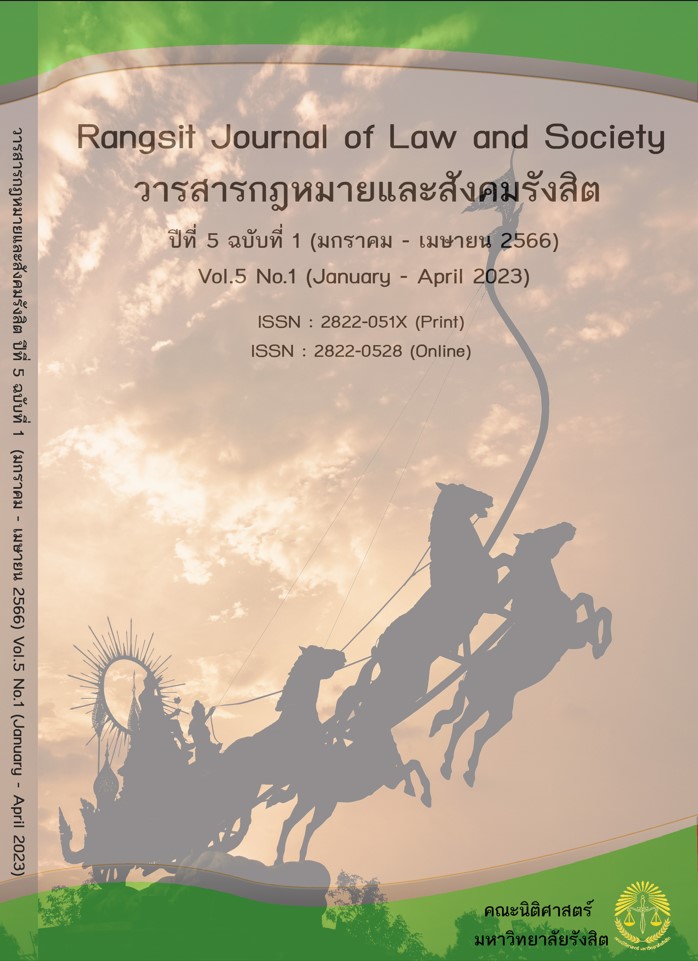เหตุยกเว้นโทษในคดีอาญา: กรณีใช้สื่อเทคโนโลยีสารสนเทศ ของพระภิกษุในพระพุทธศาสนา
Main Article Content
บทคัดย่อ
ในปัจจุบันพระภิกษุใช้สื่อเทคโนโลยีเป็นไปตามยุคสมัยที่เจริญขึ้น เพื่อปรับตัวให้เข้ายุคคลดิจิทัลเต็มรูปแบบในอนาคตซึ่งมีทั้งด้านบวกและด้านลบในตัวเอง สิ่งสำคัญการใช้สื่อเทคโนโลยีสาระสนเทศ พระภิกษุต้องระมัดระวังเพราะมีผลในความรับผิดแบบฆราวาสด้วย ในเหตุยกเว้นโทษนี้เอง เมื่อพระภิกษุไปละเมิดผู้อื่น และเข้าองค์ประกอบความผิดทางอาญา ตามประมวลกฎหมายอาญา ฐานดูหมิ่นตามมาตรา 393 และหมิ่นประมาทตามมาตรา 326 แล้วนั้น ความรับผิดแม้ว่าเป็นพระภิกษุต้องได้รับโทษในทางอาญาเช่นเดียวกันกับประชาชนทั่วไป พระภิกษุในพระพุทธศาสนาต้องให้ความสำคัญกับการใช้สื่อเทคโนโลยีสารสนเทศให้มาก เพื่อความมั่นคงของพระพุทธศาสนาและป้องกันบุคคลากรสำคัญของศาสนาในการที่ไม่สำรวมระวังทำให้ศาสนา มัวหมองและต้องตกเป็นจำเลยของสังคม
ส่วนเรื่องเหตุยกเว้นโทษตามพระวินัยมีเหตุ 4 อย่าง ที่ผู้กระทำผิดไม่ต้องรับโทษทางพระวินัยพอสรุปได้ดังนี้
- 1. ภิกษุเป็นบ้าจนไม่มีสติสัมปชัญญะหรือเป็นบ้าเพราะดีกำเริบ
- 2. ภิกษุผู้เพ้อถึงไม่รู้สึกตัว หรือเป็นบ้าเพราะสัญญาวิปลาส
- 3. ภิกษุผู้กระสับกระส่ายเพราะเวทนากล้า ถึงไม่มีสติ หรือเป็นบ้าเพราะจิตฟุ้งซ่าน
- 4. ภิกษุผู้ก่อให้ทรงบัญญัติสิกขาบท ที่เรียกว่าต้นบัญญัติ
พระวินัย ไม่ได้รับรองสิทธิหรืออำนาจอันชอบธรรมเหมือนในเหตุยกเว้นโทษในคดีอาญา ฉะนั้นพระภิกษุจะอ้างว่าทำเพื่อป้องกันสิทธิของตนหรือทำเพราะความจำเป็นไม่ได้ เพราะหลักของพระพุทธศาสนาสอนให้ละให้ปล่อยวาง ไม่ให้ยึดมั่นถือมั่นในสิ่งทั้งปวงว่านั่นเป็นเรา หรือทำเพราะความจำเป็นเพื่อให้พ้นอาบัติไม่ได้ (ปลื้ม โชติษฐยางกูร, 2559) กรณีใช้สื่อเทคโนโลยีสารสนเทศก็เช่นกันเมื่อไปละเมิดสิทธิของผู้อื่น ในทางอาญาจะอ้างเหตุเพราะไม่รู้กฎหมายไม่ได้เช่นกัน
Article Details

อนุญาตภายใต้เงื่อนไข Creative Commons Attribution-NonCommercial-NoDerivatives 4.0 International License.
เอกสารอ้างอิง
โกเมศ ขวัญเมือง. (2550). กฎหมายอาญาชั้นสูง. กรุงเทพมหานคร: สำนักพิมพ์ วิญญูชน, หน้า 87.
คณิต ณ นคร. (2529). โครงสร้างความผิดอาญาและข้อถกเถียงทางวิชาการเกี่ยวกับ Mens Rea. วารสารนิติศาสตร์, 16(3).
คณิต ณ นคร. (2560). เหตุยกเว้นโทษเฉพาะตัว. วารสารนิติศาสตร์, 16(2).
คณิต ณ นคร. (2563). กฎหมายอาญา ภาคทั่วไป, พิมพ์ครั้งที่ 7. กรุงเทพมหานคร: สำนักพิมพ์วิญญูชน.
ชานนท์ ศรีสาตร์. (2545). ปัญหาเจตนาในกฎหมายอาญา. ใน วิทยานิพนธ์ปริญญามหาบัณฑิตคณะนิติศาสตร์. กรุงเทพมหานคร: บัณฑิตวิทยาลัย มหาวิทยาลัยธุรกิจบัณฑิตย์.
ปลื้ม โชติษฐยางกูร. (2559). คำบรรยายกฎหมายคณะสงฆ์, พิมพ์ครั้งที่ 3. กรุงเทพมหานคร: สำนักพิมพ์มหาวิทยาลัยมหาจุฬาลงกรณราชวิทยาลัย, หน้า 47-48.
ยงยุทธ ชมไชย. (2566). เทคโนโลยีสารสนเทศและการสื่อสาร. เรียกใช้เมื่อ 30 มกราคม 2566 จาก Saraburiwitthayakhom Schoo: https://sites.google.com/site/kruyutsbw/-thekhnoloyi-sarsnthes-laea-kar-suxsar.
สุรศักดิ์ ลิขสิทธิ์วัฒนกุล. (2535). ข้อถกเถียงทางวิชาการ เกี่ยวกับเหตุยกเว้นโทษ. วารสารนิติศาสตร์, 22(1), หน้า 76.
หยุด แสงอุทัย. (2483). การวินิจฉัยปัญหาคดีอาญา. กรุงเทพมหานคร: บทบัณฑิตย์ เล่ม 11.
หยุด แสงอุทัย. (2548). คำอธิบายกฎหมายลักษณะอาญา ร.ศ. 127, พิมพ์ครั้งที่ 6. กรุงเทพมหานคร: สำนักพิมพ์วิญญูชน.

